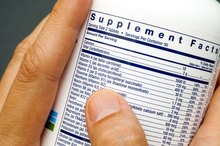The Recommended Multivitamins for a 3 Year Old
If your 3-year-old refuses to eat anything but cheesy noodles and chicken fingers, don’t fret. Many preschool-aged children are notoriously picky eaters, but that doesn’t guarantee that they are deficient in nutrients, according to MayoClinic.com. Have a conversation with your pediatrician to see if she recommends giving your 3-year-old a daily multivitamin.
Before You Buy
Your 3-year-old should be fine without a multivitamin if he is getting at least some protein, vegetables, fruit and dairy on a daily basis. However, your pediatrician may recommend that you give your preschooler a multivitamin if he doesn’t eat regularly, if he isn’t getting enough vitamin D through sunlight or diet, if he has a nutrient deficiency such as anemia, if he has a chronic disease or food allergy, if he has been diagnosed with failure to thrive or if he is on a restricted diet such as one that doesn’t include meat.
Ideal Vitamin for Your Child
What If My Child Ate Too Many Vitamins?
Learn More
If your pediatrician says your preschooler doesn’t absolutely need a supplement but you’re insistent upon giving your child one anyway, a dose a day of a generic children’s multivitamin shouldn’t cause any nutrient-overdose dangers. Look for a vitamin designed especially for small children. In many cases, you will need to split the vitamin dose in half old because most children’s vitamins are designed for children 4 and older. Let your pediatrician guide your purchase if he says your child has a special nutrient need. For example, your child may need a multivitamin rich in vitamin B-12 if she is a vegetarian. If she is anemic, she may need an iron supplement or a multivitamin supplement that contains a sufficient dose of iron.
- If your pediatrician says your preschooler doesn’t absolutely need a supplement but you’re insistent upon giving your child one anyway, a dose a day of a generic children’s multivitamin shouldn’t cause any nutrient-overdose dangers.
Considerations
Most multivitamin supplements don’t contain 100 percent of each vitamin and mineral your preschooler needs. Even if your child’s multivitamin is rich in most nutrients, dietary supplements aren’t supposed to substitute healthy eating because they can’t fully replicate the same benefits and nutrients your child gets from whole foods, according to MayoClinic.com. Continue to offer your preschooler healthy foods. Most active 3-year-olds need about 3 oz. of grains – at least half of which should be whole grains such as oatmeal – in addition to 1 cup of vegetables, 1 cup of fruits, 2 cups of dairy and 2 oz. of protein foods each day. One way to make healthy foods more appetizing to preschoolers is to make them more visually appealing. For instance, spread peanut butter on a piece of whole-wheat toast and decorate it with a happy face made out of banana slices.
- Most multivitamin supplements don’t contain 100 percent of each vitamin and mineral your preschooler needs.
Safety
Vitamins for a 2-Year-Old
Learn More
Closely read the dosing information on the label of the multivitamin you’re giving your child. If your pediatrician recommends a multivitamin that is designed for children ages 4 and up, ask her how you can make the dose size appropriate for a 3-year-old. Never give your child a dose any larger than is recommended on the product label. Giving him extra vitamins may seem like a good idea on a day when he isn’t eating well, but extra amounts of certain vitamins could be toxic. For this reason, you should also keep the multivitamins in a childproof container far higher than your child’s reach.
- Closely read the dosing information on the label of the multivitamin you’re giving your child.
- If your pediatrician recommends a multivitamin that is designed for children ages 4 and up, ask her how you can make the dose size appropriate for a 3-year-old.
Related Articles
References
- Baby Center: Nutrition Guidelines for Young Children
- MayoClinic.com: Multivitamins: Do Young Children Need Them?
- Baby Center: The Lowdown on Children’s Vitamins
- “Parenting”; Vitamins for Picky Eaters; Dr. Claire McCarthy
- MayoClinic.com: Dietary Supplements: Nutrition in a Pill?
- Sawka, M. N., Burke, L. M., Eichner, E. R., Maughan, R. J., Montain, S. J., & Stachenfeld, N. S. (2007). American College of Sports Medicine position stand. Exercise and fluid replacement. Medicine and Science in Sports and Exercise, 39(2), 377-390.
- Van der Beek, E. J. (1985). Vitamins and endurance training food for running or faddish claims? Sports Medicine, 2(3), 175-197.
- Hunt, J. R. (2003). Bioavailability of iron, zinc, and other trace minerals from vegetarian diets. The American Journal of Clinical Nutrition, 78(3), 633S-639S.
Writer Bio
Christa Miller is a writing professional with expertise in massage therapy and health. Miller attended San Francisco State University to earn a Bachelor of Arts in creative writing with a minor in journalism and went on to earn an Arizona massage therapy license.









